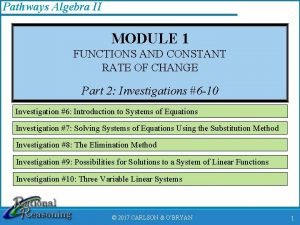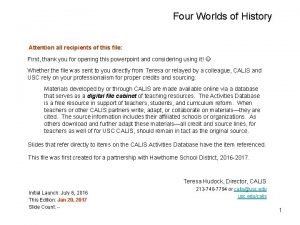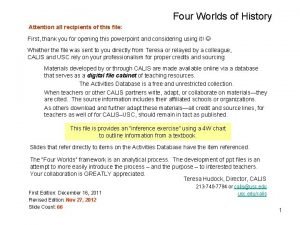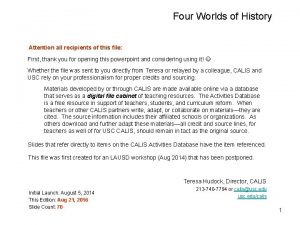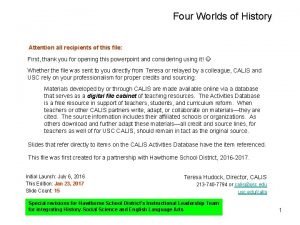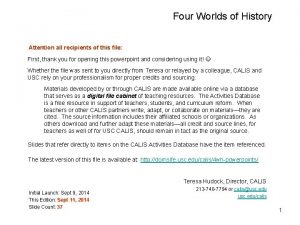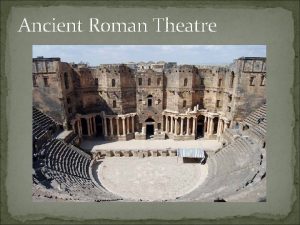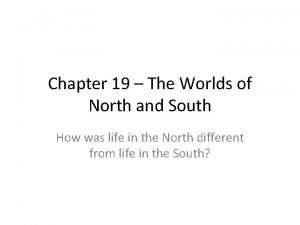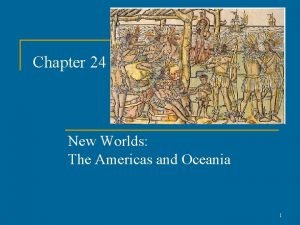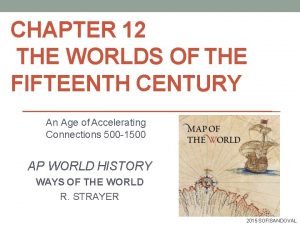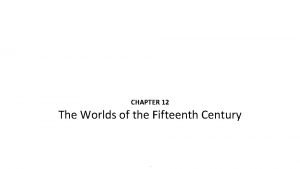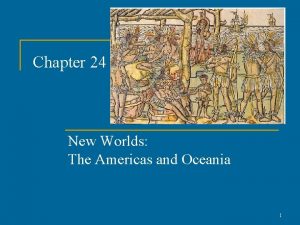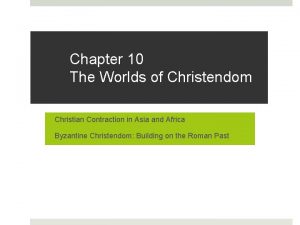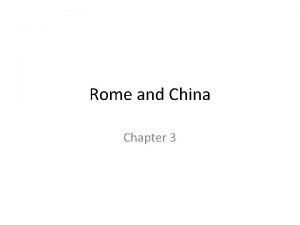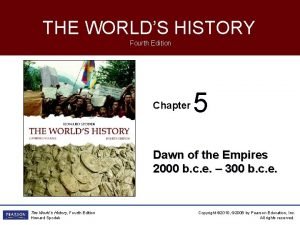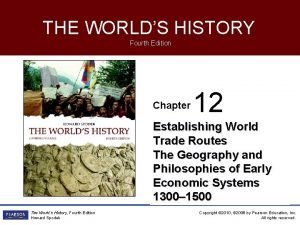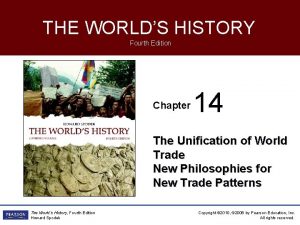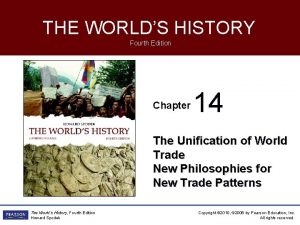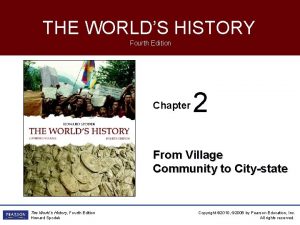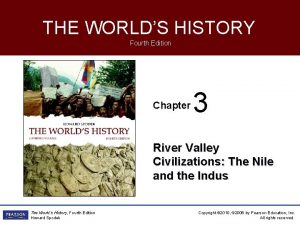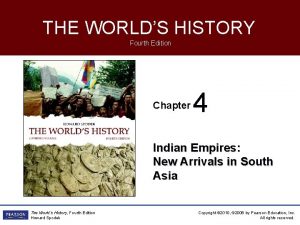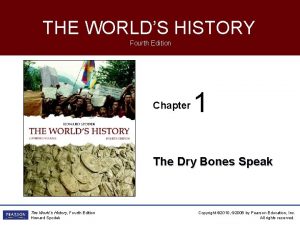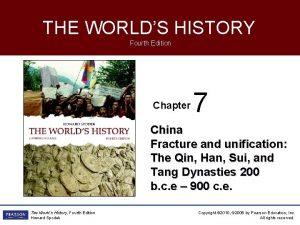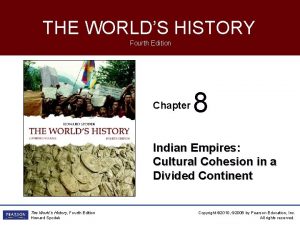THE WORLDS HISTORY Fourth Edition Chapter 6 Rome


































- Slides: 34

THE WORLD’S HISTORY Fourth Edition Chapter 6 Rome and the Barbarians The Rise and Dismemberment of Empire 750 b. c. e – 500 b. c. e. The World’s History, Fourth Edition Howard Spodek Copyright © 2010, © 2006 by Pearson Education, Inc. All rights reserved.

Rome and the Barbarians • At height, 2 nd century C. E. , Roman Empire contained 70 -100 million people in an empire reaching 2, 700 miles east to west and 2, 500 miles north to south • Rome enforced Pax Romana across empire • Contemporaries praised it for promoting peace and prosperity while critics claimed Pax Romana was brute military conquest The World’s History, Fourth Edition Howard Spodek Copyright © 2010, © 2006 by Pearson Education, Inc. All rights reserved.

From Hill Town to Republic • The Founding of the Roman Republic – Founded in 753 B. C. E. [in legend] – Ruled for 250 years by Etrurians [Etruscans] – Republic created in 509 B. C. E. when upper-class Romans drove Etruscans out of city – New republican government had two consuls and a Senate using a system of checks and balances The World’s History, Fourth Edition Howard Spodek Copyright © 2010, © 2006 by Pearson Education, Inc. All rights reserved.

The World’s History, Fourth Edition Howard Spodek Copyright © 2010, © 2006 by Pearson Education, Inc. All rights reserved.

The World’s History, Fourth Edition Howard Spodek Copyright © 2010, © 2006 by Pearson Education, Inc. All rights reserved.

From Hill Town to Republic • Conquest of Italy 396– 264 B. C. E. – Punic Wars § Rivalry of Carthage § First Punic War 264– 241 B. C. E. ; Roman conquest of Sicily § Second Punic War 219– 202 B. C. E. • The threat of Hannibal (247– 183 B. C. E. ) § Third Punic War 149– 146 B. C. E. ; destruction of Carthage – Conquests in Europe and Near East The World’s History, Fourth Edition Howard Spodek Copyright © 2010, © 2006 by Pearson Education, Inc. All rights reserved.

The World’s History, Fourth Edition Howard Spodek Copyright © 2010, © 2006 by Pearson Education, Inc. All rights reserved.

Social World of the Late Republic • Social War and extension of Roman citizenship to Italians • Patron/client relationship – Protection/dependence as social glue • Family – Power of paterfamilias – Position of women in Roman society The World’s History, Fourth Edition Howard Spodek Copyright © 2010, © 2006 by Pearson Education, Inc. All rights reserved.

Social World of the Late Republic • Struggle of the Orders 494– 440 B. C. E. – Patrician v. plebeian – Limitations on absolute power of the rich The World’s History, Fourth Edition Howard Spodek Copyright © 2010, © 2006 by Pearson Education, Inc. All rights reserved.

Social World of the Late Republic • The late Republican struggle between nobles and the poor (cont. ) – Extremes of wealth and poverty in Rome – Great reform effort: the Gracchi (130 s and 120 s B. C. E. ) § New violence of Roman politics § Support of poor as political strategy § Noble/poor conflict paved way for end of Republic The World’s History, Fourth Edition Howard Spodek Copyright © 2010, © 2006 by Pearson Education, Inc. All rights reserved.

Social World of the Late Republic • “Bread and circuses” • Slaves – Very widespread slavery – Three great slave revolts The World’s History, Fourth Edition Howard Spodek Copyright © 2010, © 2006 by Pearson Education, Inc. All rights reserved.

Military Might • A. Militarism = central to Roman ideology • Generals as politicians – Marian reform of army: recruitment of propertyless soldiers – New dependence of soldiers on their generals The World’s History, Fourth Edition Howard Spodek Copyright © 2010, © 2006 by Pearson Education, Inc. All rights reserved.

Military Might • First Triumvirate – Rise of G. Julius Caesar – Conquest of Gaul – Caesar as dictator • Octavian - Antony civil war for sole control of Roman state The World’s History, Fourth Edition Howard Spodek Copyright © 2010, © 2006 by Pearson Education, Inc. All rights reserved.

From Republic to Empire • Establishment of the principate – Octavian (Augustus Caesar) as sole ruler 30 B. C. E. – 14 C. E. § Rule of Augustus as “golden age” – Augustus as imperator – Further conquests The World’s History, Fourth Edition Howard Spodek Copyright © 2010, © 2006 by Pearson Education, Inc. All rights reserved.

The World’s History, Fourth Edition Howard Spodek Copyright © 2010, © 2006 by Pearson Education, Inc. All rights reserved.

The World’s History, Fourth Edition Howard Spodek Copyright © 2010, © 2006 by Pearson Education, Inc. All rights reserved.

From Republic to Empire • Economic life in the Empire – Exploitation of subject peoples – The problem of decadence – Flourishing of trade and administrative cities – Luxury trade and its profits The World’s History, Fourth Edition Howard Spodek Copyright © 2010, © 2006 by Pearson Education, Inc. All rights reserved.

The World’s History, Fourth Edition Howard Spodek Copyright © 2010, © 2006 by Pearson Education, Inc. All rights reserved.

Roman Culture • The deep influence of Greece • Virgil and the rhetoric of greatness • Stoicism The World’s History, Fourth Edition Howard Spodek Copyright © 2010, © 2006 by Pearson Education, Inc. All rights reserved.

Roman Culture • Roman religion – Greco-Roman polytheism – Addition of a cult of deified emperors § Addition of mystery religions § Mithraism § Cybele, Isis – Tolerance of all religions that weren’t harmful to the state The World’s History, Fourth Edition Howard Spodek Copyright © 2010, © 2006 by Pearson Education, Inc. All rights reserved.

The World’s History, Fourth Edition Howard Spodek Copyright © 2010, © 2006 by Pearson Education, Inc. All rights reserved.

The World’s History, Fourth Edition Howard Spodek Copyright © 2010, © 2006 by Pearson Education, Inc. All rights reserved.

The World’s History, Fourth Edition Howard Spodek Copyright © 2010, © 2006 by Pearson Education, Inc. All rights reserved.

Roman Culture • Roman religion (cont. ) – Triumph of Christianity § Persecution § Constantine and the Peace of the Church § Outlawing of polytheism 394 C. E. The World’s History, Fourth Edition Howard Spodek Copyright © 2010, © 2006 by Pearson Education, Inc. All rights reserved.

Transformation of the Roman Empire • The problem of “barbarians” – Celts § Arrival in Europe c. 2000 B. C. E. § Expansion/threat to Mediterranean c. 400 B. C. E. on § Defeats by Romans – Germans § Many conflicts along frontier § Gradual settlement of Germanic tribes within western Empire The World’s History, Fourth Edition Howard Spodek Copyright © 2010, © 2006 by Pearson Education, Inc. All rights reserved.

Transformation of the Roman Empire • The problem of “barbarians” – Steppe peoples, especially Huns § Huns upset balance of borders c. 370 C. E. § Move of Goths into imperial territory to escape Huns The World’s History, Fourth Edition Howard Spodek Copyright © 2010, © 2006 by Pearson Education, Inc. All rights reserved.

The World’s History, Fourth Edition Howard Spodek Copyright © 2010, © 2006 by Pearson Education, Inc. All rights reserved.

Transformation of the Roman Empire • Dismemberment of Empire – Plague – Third-century crisis: series of invasions – Division into eastern and western empires – Settlement of Germans within Empire as “federates” – 410 sack of Rome – 476 abdication of last western emperor The World’s History, Fourth Edition Howard Spodek Copyright © 2010, © 2006 by Pearson Education, Inc. All rights reserved.

Transformation of the Roman Empire • Causes for the “fall” – Military = too expensive for its economic base – No fixed system of imperial succession – Germans The World’s History, Fourth Edition Howard Spodek Copyright © 2010, © 2006 by Pearson Education, Inc. All rights reserved.

The World’s History, Fourth Edition Howard Spodek Copyright © 2010, © 2006 by Pearson Education, Inc. All rights reserved.

Eastern Roman Empire (Byzantine Empire) • Survival of eastern empire • Resurgence under Justinian I (r. 527– 565 C. E. ) – Justinian Code – Reconquest of much of the West The World’s History, Fourth Edition Howard Spodek Copyright © 2010, © 2006 by Pearson Education, Inc. All rights reserved.

Eastern Roman Empire (Byzantine Empire) • Religious Disputes – Monophysites – Iconoclasm • Build-up of strong Byzantine bureaucracy The World’s History, Fourth Edition Howard Spodek Copyright © 2010, © 2006 by Pearson Education, Inc. All rights reserved.

The World’s History, Fourth Edition Howard Spodek Copyright © 2010, © 2006 by Pearson Education, Inc. All rights reserved.

Legacy of the Roman Empire • Linguistic • Legal • Urban • Transformation of Roman administration by Christian church The World’s History, Fourth Edition Howard Spodek Copyright © 2010, © 2006 by Pearson Education, Inc. All rights reserved.
 Worlds together worlds apart 4th edition
Worlds together worlds apart 4th edition Project 2 fourth edition
Project 2 fourth edition Algebra 2 module 1 answer key
Algebra 2 module 1 answer key Ethics in information technology fourth edition
Ethics in information technology fourth edition Ethics in information technology 6th edition answers
Ethics in information technology 6th edition answers Project 4 fourth edition
Project 4 fourth edition A computer programming team has 13 members
A computer programming team has 13 members Expert systems: principles and programming, fourth edition
Expert systems: principles and programming, fourth edition Four worlds of history
Four worlds of history The four worlds of history
The four worlds of history Four worlds chart
Four worlds chart Four worlds of history
Four worlds of history The four worlds of history
The four worlds of history Using mis 10th edition
Using mis 10th edition Report
Report Ancient roman plays
Ancient roman plays Lesson 19 the worlds of north and south answer key
Lesson 19 the worlds of north and south answer key Chapter 24 new worlds the americas and oceania
Chapter 24 new worlds the americas and oceania Chapter 24 the americas and oceania
Chapter 24 the americas and oceania Chapter 20 the americas and oceania
Chapter 20 the americas and oceania Chapter 12 worlds of the 15th century
Chapter 12 worlds of the 15th century The worlds of the fifteenth century
The worlds of the fifteenth century Chapter 10 the worlds of christendom notes
Chapter 10 the worlds of christendom notes Western christendom ap world history
Western christendom ap world history Chapter 24 the americas and oceania
Chapter 24 the americas and oceania Chapter 10 the worlds of christendom notes
Chapter 10 the worlds of christendom notes Chapter 1 section 5 transatlantic encounters
Chapter 1 section 5 transatlantic encounters Concise history of western music 5th edition
Concise history of western music 5th edition Hát kết hợp bộ gõ cơ thể
Hát kết hợp bộ gõ cơ thể Frameset trong html5
Frameset trong html5 Bổ thể
Bổ thể Tỉ lệ cơ thể trẻ em
Tỉ lệ cơ thể trẻ em Chó sói
Chó sói Chụp tư thế worms-breton
Chụp tư thế worms-breton Chúa yêu trần thế alleluia
Chúa yêu trần thế alleluia


